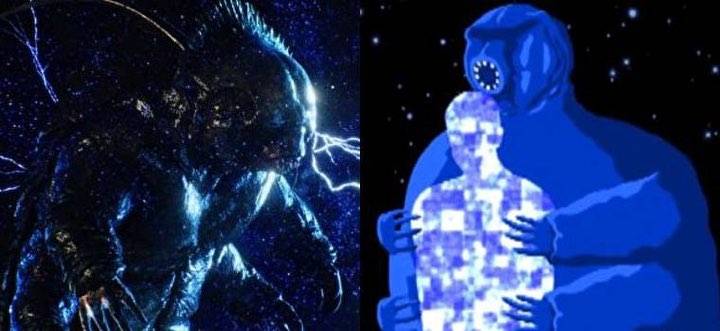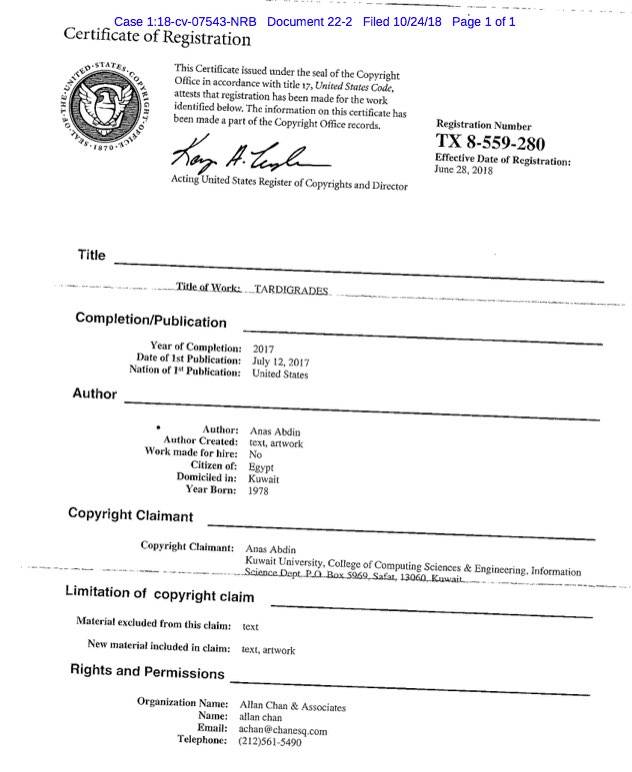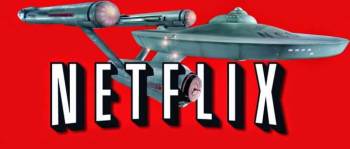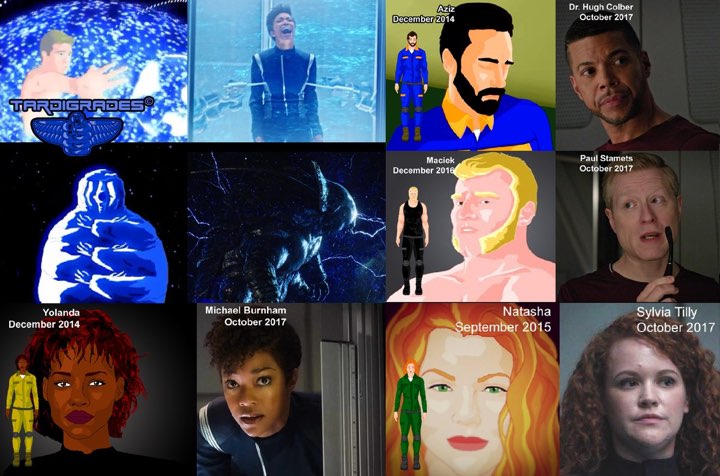 SUPERFICIAL SIMILARITIES? The defense’s grounds for dismissing the copyright lawsuit against Star Trek: Discovery call the similarities between it and the Tardigrades videogame “generic.”
SUPERFICIAL SIMILARITIES? The defense’s grounds for dismissing the copyright lawsuit against Star Trek: Discovery call the similarities between it and the Tardigrades videogame “generic.”
DECEMBER 6, 2018 | ESTIMATED READING TIME 13 MINS
The Case For and Against Dismissing the Tardigrades Suit
Plaintiff Replies to Flaws Found by CBS Lawyer in Copyright Infringement Case Against Star Trek: Discovery
Table of Contents
Just what’s wrong with the lawsuit against CBS and Netflix over Star Trek: Discovery, which developer Anas Abdin claims infringes on his unreleased videogame, Tardigrades?
In a December 3, 2018, letter to the U.S. District Court judge in the case, attorney Wook Hwang spelled out precisely why he believed the case shouldn’t move forward: Essentially, that Abdin’s claims that Discovery stole his ideas, and that Netflix (Discovery‘s international distributor) is equally liable, don’t hold up under the law.
For his part, Abdin replied through his lawyers, John Johnson and Allan Chan, on December 5 with a letter to the judge answering Hwang’s criticism.
UPDATE: New Judge
The Tardigrades lawsuit was assigned to another judge, Lorna G. Schofield, on December 11, 2018.
Conference Scheduled
U.S. District Judge Lorna G. Schofield scheduled a pre-motion conference regarding the defense’s planned motion to dismiss the case. That conference will be January 8, 2019, in New York. Ahead of that meeting, each side must filed a status letter and case management plan by January 2.
'In the Plaintiff's Favor'
Abdin’s lawyers questioned the propriety of any motion to dismiss their case based on the defense’s arguments to the judge, citing federal rules of civil procedure by quoting Arma v. Buyseasons Inc.:
In considering a motion to dismiss … the court construes the complaint liberally, “accepting all factual allegations in the complaint as true, and drawing all reasonable inferences in the plaintiff’s favor.”1)
However, Hwang’s letter did not argue against the facts Abdin asserted in his suit, but on whether his lawyers properly applied the relevant law to those facts. In her upcoming ruling, the judge will decide which interpretation of civil procedure to follow.
Substantially Similar?
At the heart of CBS/Netflix’s defense is the idea that Discovery and Tardigrades, despite some superficial similarities, are not substantially similar — a critical test against which copyright infringement claims must hold up.
What is Substantial Similarity?
According to the American Bar Association, in copyright infringement cases courts traditionally test for substantial similarity using “a subjective, factual analysis called the ‘audience test,’” whose goal is to see if ordinary observers, unless they set out to detect the differences between the works, “would regard their aesthetic appeal as the same.”2)
Moreover, the audience test “asks whether the defendant wrongly copied enough of the plaintiff’s protected expression to cause a reasonable lay observer to immediately detect the similarities between the plaintiff’s expression and the defendant’s work, without any aid or suggestion from others.”3)
Abdin’s lawyers argued “the proof that a lay observer would not overlook the similarities [between Tardigrades and Discovery] can be found in the many YouTube and gamer websites’ discussions” of the case.4)
Of course, many of those commenters, possibly predisposed to advocating for independent videogame developers, do not understand copyright, particularly its not protecting ideas, only expressions of ideas. Hwang cited the 2010 case, Peter F. Gaito Architecture, LLC v. Simone Development Corp. to assert that the lay observers who count are those who would qualify to sit on a jury.
Furthermore, Hwang argued, a trial would include instructing jurors about how copyright law should be applied. “No reasonable jury,” he quoted from Gaito, “properly instructed, could find that the two works are substantially similar.”5)
Four Remedies for Infringement
Hwang, of the Loeb & Loeb law firm, characterized Abdin’s case arising from the “common use of enlarged, space-based tardigrades and an assortment of other random ‘similarities’ (e.g., a gay male couple),” by asserting four claims of copyright infringement, seeking four separate remedies:
- A permanent injunction against production of Star Trek: Discovery.
- Actual damages resulting from the alleged infringement.
- Statutory damages allowed under U.S. copyright law.
- Attorneys’ fees and costs.
In their reply Abdin’s lawyers struck back at Hwang’s analysis, saying, “The defendants have misrepresented the factual scenario [in] this matter and therefore attempt to conform the misrepresentation to the law.”
Other Copyright Violations
According to Hwang, Abdin’s suite also alleges violations of the Berne Convention, an international copyright agreement, and the Visual Artists Rights Act of 1990 (VARA).
Unprotected Elements
The defense refers to the legal principle that copyright law doesn’t protect an idea, merely a creator’s original and specific expression of an idea. According to Hwang, whatever similar elements exist in both the Tardigrades game and Discovery are different original expressions of what might be common ideas.
For example, Hwang argued, Abdin cannot copyright the idea of tardigrades since they are real creatures that exist in nature, nor can he claim ownership of the idea of human-sized tardigrades in space:
That tardigrades are able to survive unprotected in space is a scientific fact that is not original to (much less exclusively owned by) Plaintiff. Nor can Plaintiff claim ownership of the basic idea of using tardigrades in a fictional space-based story, any more than an author could claim copyright protection over the idea of placing dinosaurs on a fictional island zoo.6)
Only Abdin’s particular visual representation of a tardigrade can be copyrighted; Discovery‘s tardigrade is presented using a very different “aesthetic appeal” (see “What is Substantial Similarity?”).
CBS attorney Wook Hwang criticized Anas Abdin’s ‘bare and speculative allegations’ that any of the defendants had the access to actually copy Abdin’s unreleased videogame. — ‘No Proof of Access’
In their reply, Abdin’s lawyers acknowledged tardigrades were a creature found in nature but that “via his imagination and ingenuity” Abdin’s description of his game centered on a “giant blue Tardigrade that travels instantly throughout the world of outer space,” an ability that does not exist in nature. Discovery‘s tardigrade, however, is not blue. The creature is brown, though depicted in some scenes bathed in blue light, a common lighting treatment in sci-fi film and television.
Abdin’s attorneys went on to describe “the tardigrade’s power of instantaneous space travel was the central theme of the show [Star Trek: Discovery].”7) Presumably, the central theme of the show was Michael Burnham’s redemption after violating Starfleet principles to start the Klingon war; the means of travel employed by a starship was part of the show’s setting not its theme.
In a claim echoed throughout the letter, Abdin’s attorneys cited case law demonstrating his version of a tardigrade deserved copyright protection, including DeBecdelievre v. Anastasia Musical LLC, which found that where facts (such as teleporting tardigrades) “do not exist and are created from the imagination, copyrightable protection exists for the creation.”8)
However, Hwang’s letter does not argue Abdin cannot copyright his version of a space-traveling tardigrade. He only disputes whether that copyright extends beyond Abdin’s particular depiction of such a creature to protect the very idea of a tardigrade that can travel through space; copyright law, of course, doesn’t protect ideas, only their specific expression.
Human Domino
Furthermore, Hwang argued, Abdin’s cannot claim his space-faring adaptation of actual tardigrades is protected by copyright, as the idea naturally flowed from the very notion of a tardigrade-based character. Hwang pointed to a relevant case involving Domino’s Pizza human-sized domino character in the 1997 case Ollie v. Domino’s Pizza, Inc., which found that “the humanizing of a domino is an idea not subject to copyright protection.”9)
Abdin’s lawyers countered that Hwang misused the Domino’s case’s conclusions:
The court in Ollie held that the two figures were wholly different … “although the Dominoid and Donny Domino are similar, in that their bodies consist of a domino with one dot in the top square and two dots in the bottom square, the court find the this similarity is attributable to the fact that both works used Domino’s trademarked domino as the body. … However, the humanizing of a domino is an idea not subject to copyright protection.”10)
That last sentence, however, is precisely how Hwang cited the Ollie case.
« It’s as if the plaintiff’s original work was used as a storyboard for the development of Star Trek: Discovery. » — Attorneys for Anas Abdin
Furthermore, Hwang noted that the notion of tardigrades in Star Trek predated Abdin’s 2014 publication of his game’s concepts, pointing to a 2013 Scientific American article by Kyle Hill, “How Tardigrades Saved the Enterprise,” in which the author opined “that Captain Kirk should have used tardigrades to save U.S.S. Enterprise in … Star Trek Into Darkness).11)
That article, however, only attached the idea of tardigrades to Star Trek, according to Abdin’s lawyers; it “does not in any way state that tardigrades could be used for instantaneous space travel or are the size of human beings.”12)
'Generic' Similarities
Having dispensed with the tardigrade’s lack of copyright protection, Hwang said all that remained of Abdin’s case were “random similarities scattered throughout the works, which cannot support a finding of substantial similarity.”13) Hwang addressed Abdin’s examples of alleged copying:
- A gay relationship.
- Uniforms delineating rank.
- Use of the term “emitter” to describe a light-emitting device.
- Stock character elements, such as:
- A blond white male scientist.
- A darker-complexion homosexual male.
- A female of African descent with messy curly hair.
Example: Copied Costumes?
Among the items listed in the lawsuit as copied by Discovery from Tardigrades are the Trek series’ uniforms. The complaint describes Tardigrades as featuring uniforms depicting characters’ ranks, for example:
“Heretofore, the Star Trek series has not used any uniform styled, or colored in this manner, until plaintiff’s [Tardigrades] was published.” Abdin called the style “a total departure from prior Star Trek uniforms,” and therefore had to have been copied from Tardigrades.14)
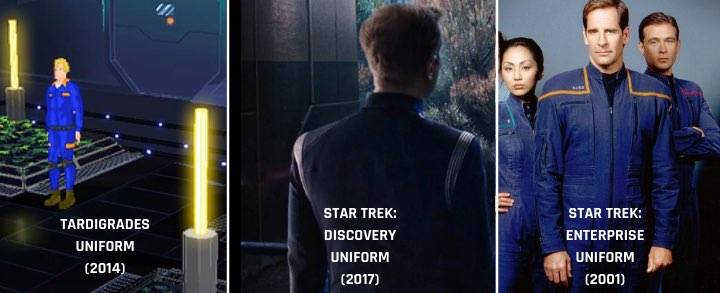
Hwang cited several copyright cases in which even more specific similarities than Abdin alleges failed to be found by courts to be protectable:
- Hogan v. DC Comics (1999), which found “a stock character or basic character type … is not entitled to copyright protection,” even including an instance “where two characters had same name and were both half-vampire and half-human, of similar age, and shared other characteristics such as ‘thin-to-medium builds, pale skin, dark messy hair and a slovenly appearance.’ Abdin’s alleged copying goes no further than describing similarly superficial similarities.15)
- Lewinson v. Henry Holt & Co., LLC (2009) rhetorically noted that, “if a stock character such as a drunken old bum were a copyrightable character, so would be a drunken suburban housewife, a gesticulating Frenchman, a fire-breathing dragon, a talking cat, a Prussian officer who wears a monocle and clicks his heels, [and] a masked magician.”16)
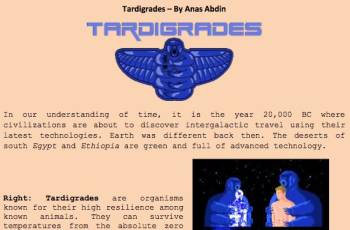
No Links to Original Works
Hwang also criticized the lawsuit’s lack of links to works Abdin claimed to have published online, beyond a short treatment attached to the legal complaint. Despite the lack of links or attachment substantiating his claims, Abdin “confusingly defines the allegedly infringed ‘Original Work’ to encompass other materials published on various websites, including Adventure Game Studio Forums, [Abdin’s own] Anas-tronaut Blog, YouTube, Steam Games and Reddit.”17)
Since the legal complaint provided no other means by which CBS/Netflix could determine what other materials posted on those sites might have been infringed upon, Hwang said Abdin did not satisfy “well-settled pleading requirements”; therefore, the case should be dismissed.”18)
Abdin’s lawyers countered his treatment “provides defendants with a list of the allegedly infringed items,” and offered to amend the legal complaint to provide more specificity, and that the legal discovery process would address the issue.
No Proof of Access
Crucially, Hwang noted, Abdin failed to demonstrate Discovery‘s creators even knew about Abdin’s game prior to his initial complaint to CBS — such access is a critical part of making a case for copyright infringement.
Hwang criticized Abdin’s ”bare and speculative allegations“ that any of the Defendants had the access to actually copy Abdin’s work. To establish access Abdin must “plausibly allege either: (1) a particular chain of events or a link from his work to the creators of the allegedly infringing work, or (2) that plaintiff’s work was widely disseminated.”19)
Instead, Abdin offers no such chain of events or link between his game and Discovery‘s development, nor do his postings on various websites constitute wide dissemination, according to the 2008 case, O’Keefe v. Ogilvy & Mather Worldwide, Inc., which established “the mere fact that [a plaintiff’s] work was posted on the internet prior to the creation of defendants’ work is insufficient by itself to demonstrate wide dissemination.”20)
However, “the defendants’ use of words such as ‘unreleased’ [and] ‘a few websites,’ is wholly misleading,” Abdin’s lawyers charged. “Hundreds of thousands of interested fans viewed the [Tardigrades game’s] treatment, thereby establishing a question of fact as to the defendants’ access.”21)
However, neither Abdin’s legal complaint nor this letter offered evidence substantiating his claimed “hundreds of thousands of fans.”
Late Copyright Registration
As for Abdin’s attempt to claim statutory damages of up to $150,000 per instance of infringement plus his cost for legal representation, Hwang argued Abdin registered his copyright with the U.S. Copyright Office in June 2018, months after Discovery premiered in September 2017 — too late to qualify.22)
“Even where the alleged infringement begins before registration and continues after registration, statutory damages and attorney fees are still unavailable,” Hwang cited from the 2016 case, Solid Oak Sketches, LLC v. 2K Games, Inc.
Abdin’s lawyers failed to address how his late copyright registration entitled him to statutory damages and attorneys’ fees. Instead, the letter claimed Abdin was entitled to such damages and fees by virtue of the Visual Artists Rights Act of 1990 (VARA), which recognizes under American law the concept of creators’ lasting moral rights to their work.
If Hwang’s reasoning is correct, however, Abdin may not be able to rely on VARA for the damages and fees he’s seeking.
Not Covered Under Berne Convention, Visual Artists' Law
Abdin’s legal complaint included claims under the international copyright agreement, the Berne Convention, and VARA.
Hwang dispensed with both these claims by arguing:
- Abdin’s claim under the international Berne Convention is irrelevant because Berne extends no copyright protection beyond that already offered under U.S. copyright law.23)
- VARA offers no protection to the Tardigrades game, which fails to meet the legal definition of “works of visual art — a narrow class of art defined to include paintings, drawings, prints, sculptures, or photographs produced for exhibition purposes, existing in a single copy or limited edition of 200 copies or fewer.”24) Abdin’s treatment — the only tangible work submitted with his legal complaint — “falls within none of these categories.”25)
While Abdin’s response failed to address the Berne Convention argument at all, his attorneys doubled down on VARA’s application to the Tardigrades game, stating, “Defendants dismiss [Abdin’s] VARA claims while on the other hand admitting the plaintiff established ‘comic book-style’ artwork. … It’s as if the plaintiff’s original work was used as a storyboard for the development of Star Trek: Discovery.”26)
However, VARA does not protect all forms of visual art, only very specific kinds, as noted in “A Guide to the Visual Artists Rights Act”:
VARA covers only limited, fine art categories of “works of visual art”: paintings, sculptures, drawings, prints, still photographs produced for exhibition. Within this group, only single copies or signed and numbered limited editions of 200 or less are actually protected. VARA does not apply to any of the following: works made for hire, posters, maps, globes or charts, technical drawings, diagrams, models, applied art, motion pictures, books and other publications, electronic publications, merchandising items or advertising, promotional, descriptive, covering, packaging material or container, nor does it cover any work not subject to general copyright protection.27)
Abdin’s work, all electronic publications, including its “comic book-style artwork,” do not appear to meet VARA’s definition of protected visual art.
Netflix in the Clear
Abdin’s attempt to extract damages from Netflix for its international distribution of Discovery (in the U.S., only CBS All Access carries the show) should fail, Hwang argued, because American copyright law cannot be applied outside the United States.
The only domestic act attributed to Netflix is [according to Abdin] having “entered into a contract in the United States with the CBS defendants.” … But the mere act of licensing allegedly infringing works for foreign use does not constitute copyright infringement. See, e.g., Fun-Damental Too, Ltd. v. Gemmy Indus. Corp (1996), (“mere authorization and approval [in the United States] of copyright infringements taking place outside the United States is not a copyright violation and does not create jurisdiction over those extraterritorial acts”).28)
While that principle is well established, Abdin’s attorneys note, there is an exception “when the type of infringement permits further reproduction abroad.” It’s unclear, though, how exactly the case they cite, Peter Starr Prod. Co. v. Twin Continental Films Inc., decided in 1986, would apply to digital streaming used by Netflix three decades later. 
COMMENTS
Discuss this article in AxaMonitor's Facebook group.
Keywords

